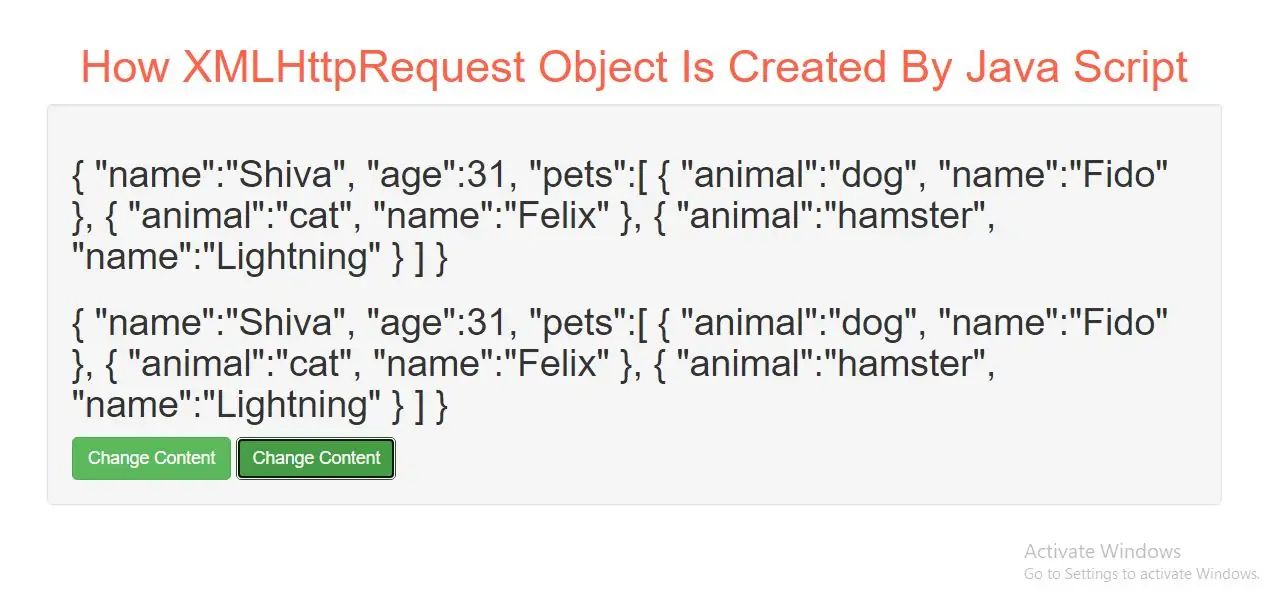
The XMLHttpRequest Object
All modern browsers support the XMLHttpRequest object.
The XMLHttpRequest object can be used to exchange data with a web server behind the scenes. This means that it is possible to update parts of a web page, without reloading the whole page.
Create an XMLHttpRequest Object
All modern browsers (Chrome, Firefox, IE7+, Edge, Safari, Opera) have a built-in XMLHttpRequest object.
Syntax for creating an XMLHttpRequest object:
variable = new XMLHttpRequest();
Example(1)
<button class="btn btn-success" type="button" onclick="loadDoc()">Change Content</button>
<script>
function loadDoc() {
var xhttp = new XMLHttpRequest();
xhttp.onreadystatechange = function() {
if (this.readyState == 4 && this.status == 200) {
document.getElementById("demo").innerHTML = this.responseText;
}
};
xhttp.open("GET", "demo.txt", true);
xhttp.send();
}
</script>
Access Across Domains
For security reasons, modern browsers do not allow access across domains.
This means that both the web page and the XML file it tries to load, must be located on the same server.
The examples on W3Schools all open XML files located on the W3Schools domain.
If you want to use the example above on one of your own web pages, the XML files you load must be located on your own server.
Old versions of Internet Explorer (5/6) use an ActiveX object instead of the XMLHttpRequest object:
variable = new ActiveXObject("Microsoft.XMLHTTP");
To handle IE5 and IE6, check if the browser supports the XMLHttpRequest object, or else create an ActiveX object:
Example(2)
<button class="btn btn-success" type="button" onclick="loadDoc()">Change Content</button>
<script>
function loadDoc1() {
var xhttp;
if (window.XMLHttpRequest) {
// code for modern browsers
xhttp = new XMLHttpRequest();
} else {
// code for IE6, IE5
xhttp = new ActiveXObject("Microsoft.XMLHTTP");
}
xhttp.onreadystatechange = function() {
if (this.readyState == 4 && this.status == 200) {
document.getElementById("demo1").innerHTML = this.responseText;
}
};
xhttp.open("GET", "demo.txt", true);
xhttp.send();
}
</script>
Complete Code For AJAX XMLHttpRequest Object Used With JavaScript.
<!DOCTYPE html>
<html>
<head>
<title>How XMLHttpRequest Object created With JavaScript</title>
<meta charset="utf-8">
<meta name="viewport" content="width=device-width, initial-scale=1">
<link rel="stylesheet" href="https://maxcdn.bootstrapcdn.com/bootstrap/3.4.1/css/bootstrap.min.css">
</head>
<body>
<div class="container">
<br>
<div class="text-center">
<h1 id="color" style="color: tomato">How XMLHttpRequest Object created With JavaScript</h1>
</div>
<div class="well">
<h2 id="demo">Let AJAX change this text.</h2>
<h2 id="demo1">Let AJAX change this text.</h2>
<button class="btn btn-success" type="button" onclick="loadDoc()">Change Content</button>
<button class="btn btn-success" type="button" onclick="loadDoc1()">Change Content</button>
<script>
function loadDoc() {
var xhttp = new XMLHttpRequest();
xhttp.onreadystatechange = function() {
if (this.readyState == 4 && this.status == 200) {
document.getElementById("demo").innerHTML = this.responseText;
}
};
xhttp.open("GET", "demo.txt", true);
xhttp.send();
}
function loadDoc1() {
var xhttp;
if (window.XMLHttpRequest) {
// code for modern browsers
xhttp = new XMLHttpRequest();
} else {
// code for IE6, IE5
xhttp = new ActiveXObject("Microsoft.XMLHTTP");
}
xhttp.onreadystatechange = function() {
if (this.readyState == 4 && this.status == 200) {
document.getElementById("demo1").innerHTML = this.responseText;
}
};
xhttp.open("GET", "demo.txt", true);
xhttp.send();
}
</script>
</div>
</div>
</body>
</html>
XMLHttpRequest Object Methods
| Method | Description |
|---|---|
| new XMLHttpRequest() | Creates a new XMLHttpRequest object |
| abort() | Cancels the current request |
| getAllResponseHeaders() | Returns header information |
| getResponseHeader() | Returns specific header information |
| open(method, url, async, user, psw) | Specifies the request method: the request type GET or POST url: the file location async: true (asynchronous) or false (synchronous) user: optional user name psw: optional password |
| send() | Sends the request to the server Used for GET requests |
| send(string) | Sends the request to the server. Used for POST requests |
| setRequestHeader() | Adds a label/value pair to the header to be sent |
XMLHttpRequest Object Properties
| Property | Description |
|---|---|
| onreadystatechange | Defines a function to be called when the readyState property changes |
| readyState | Holds the status of the XMLHttpRequest. 0: request not initialized 1: server connection established 2: request received 3: processing request 4: request finished and response is ready |
| responseText | Returns the response data as a string |
| responseXML | Returns the response data as XML data |
| status | Returns the status-number of a request 200: "OK" 403: "Forbidden" 404: "Not Found" For a complete list go to the Http Messages Reference |
| statusText | Returns the status-text (e.g. "OK" or "Not Found") |